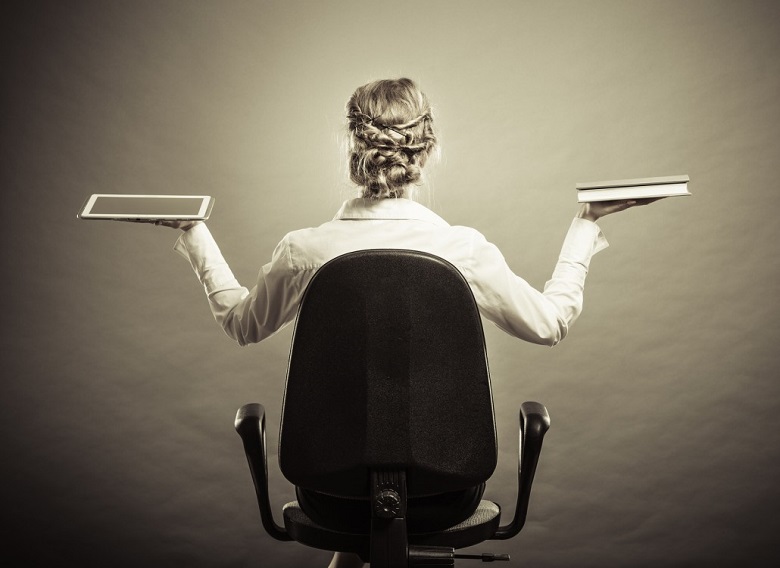Even the most reluctant of readers, who would rather die than part with their collections of paper books, must recognize one thing: the idea of being able to transport one’s ideal library almost anywhere on the planet is attractive. An e-reader can extend the good old book without burying it. The question remains which e-reader to choose and for what uses?

To turn the page, or not to turn it?
Just because we are surrounded by electronic devices – smartphones, computers and 3D printers – doesn’t mean we should get rid of our good old books. Even if libraries become digital, nothing will replace the taste of paper, the feel of the page between your fingers, the smell of the binding… or the fact of being able to turn the pages at will!
However, even bookworms can be convinced by certain arguments, including:
- Be able to download and store several thousand works;
- Carry your e-reader everywhere: it is not bulky and fits in a pocket;
- Read for hours and hours with a battery life that would make any tablet green with envy ;
- Being able to take notes, underline passages from your favorite books, and be able to work directly on your device (ideal for academics, for example).
Which e-reader should you choose on the market?
The question is not as complex as it seems. Knowing which e-reader to choose can be summed up by asking yourself which type of manufacturer to favor: the big sedans of digital screen reading, like Amazon or Fnac, or the little Thumbs of the sector who are trying to catch up with the already well-established competition.
Either other manufacturers don’t dare to take the plunge, or they have ended up giving up, as Sony recently did by closing its relevant division. It must be said that the possibilities offered by e-readers are few – they remain an object whose main purpose is to read, period – and that the competition is struggling to innovate.
In short, most e-readers have roughly the same features: a touchscreen with e-ink (6 or 8 inches, with or without backlight), a stylus or not, a few basic buttons, and a Wi-Fi connection to download books. Here are the most common models found on the market:
- The Kindle, produced by Amazon. Expect to pay around €70 for the basic model, without ads. The Paperwhite version, with a backlit screen, goes up to €130.
- The Kobo, a product stamped Fnac. The Touch 2.0 costs €90, and the Glo HD model, illuminated, offers the best e-ink screen on the market, for around €130.
- The Cybook Muse Essential or Frontlight. A Bookeen production, with or without an illuminated screen, is between €80 and €110.
- The PocketBook Tea Touch Lux 3 (a French brand), with a backlit screen for around €100. The waterproof model (for reading by the pool) goes up to €120.
Some more or less notable differences
There are a few differences between the models. These are reduced to a few characteristics that we have ranked from the most important to the most trivial:
- File formats: this is where the question of which e-reader to choose takes on its full meaning. The reading formats are not the same depending on the model: the Kindle can only read native files produced by Amazon (the AZW format), while the others accept all formats… except Amazon’s! In addition, make sure that your e-reader can read CBZ or CBR formats if you want to read Lucky Luke albums (or any other comics) on it.
- Storage: Most e-readers offer a base memory of 4 GB. If you remove the space dedicated to the system, you still have enough virtual shelves to fit some 3,000 books! Some models allow you to slide in an additional micro SD card, but will you need it?
- The screen: all use electronic ink technology. Almost all are available in a touch version. What varies is the size (6 or 8 inches in general), the resolution (from 600×800 pixels to 1440×1080 pixels), and the possibility of choosing an e-reader with a backlit screen, so that you can read without any other source of light.
- Various functions:
- The camera (for example on the PocketBook Tea Ultra). Anecdotal? Not so much: this device allows you to scan documents, with its OCR character recognition system. Enough to turn your back on photocopiers!
- 3G connection. As Wi-Fi is becoming more and more widespread, it seems hard to believe that you could need to download books urgently with a 3G connection. But it does exist, nevertheless; and in 4G too.
- Waterproof. For reading in the shower. Or, more pragmatically, to avoid the fear of impromptu jets of water near the pool.
- Turning the pages without touching the screen. Except for penguins, which seem quite useless to the reader.
Knowing which e-reader to choose depends mostly on you!
Not everyone uses this digital object in the same way. Knowing what you want to do with it is an essential prerequisite to having an idea of which e-reader to choose: where and when do you prefer to read? Do you need a 3G connection? Only then will you have to put your finger on the model that suits you.
However, for passionate book readers who simply want to give themselves every chance of being able to take their beloved works with them everywhere, the basic e-reader will suffice very well: they will use it in bright light, will not go on the Internet, and will avoid liquid projections… Just like a paper book, in short!


















